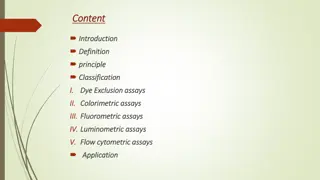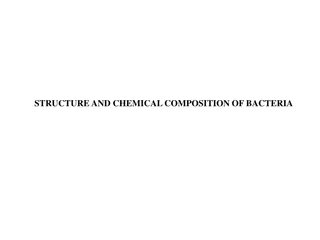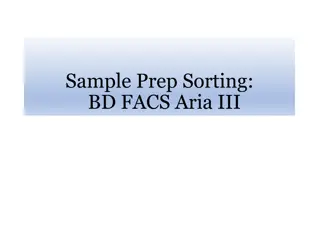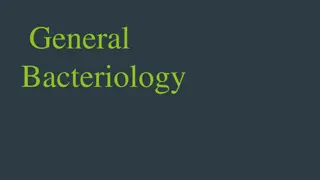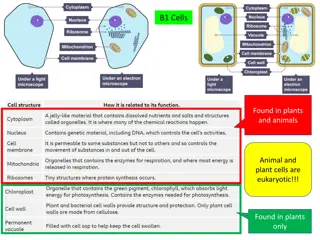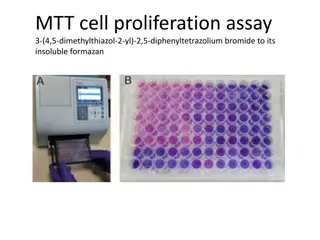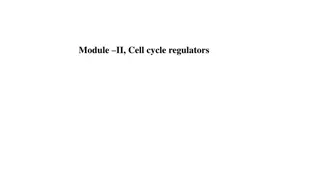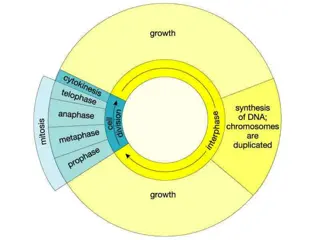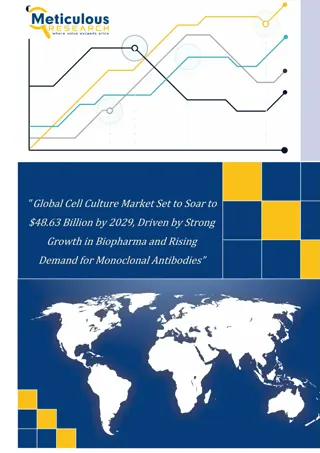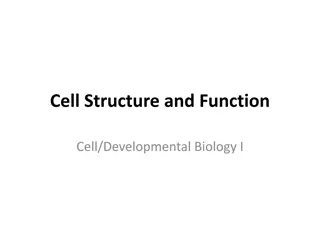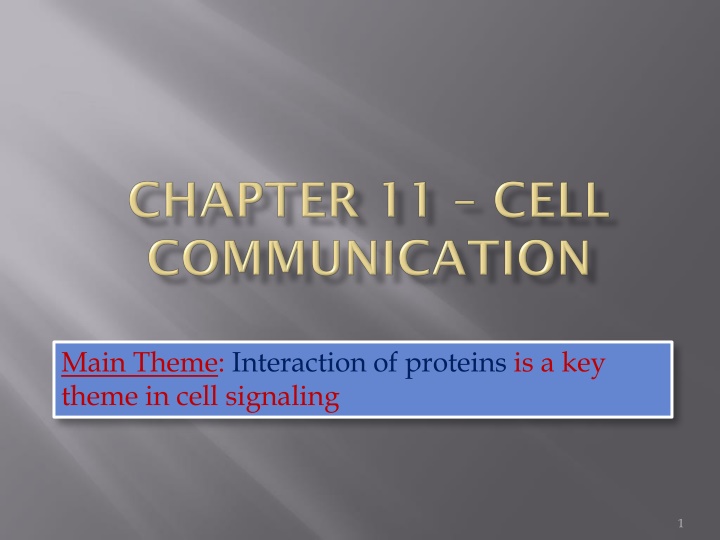
Cell Signaling and Protein Interaction in Biological Systems
Explore the crucial theme of protein interaction in cell signaling pathways, from signal transduction to the evolution of signaling molecules. Learn about the diverse mechanisms, such as hormonal, paracrine, and synaptic signaling, that govern communication between cells in both plants and animals. Delve into the groundbreaking research of American pharmacologist Sutherland on hormonal actions.
Download Presentation

Please find below an Image/Link to download the presentation.
The content on the website is provided AS IS for your information and personal use only. It may not be sold, licensed, or shared on other websites without obtaining consent from the author. If you encounter any issues during the download, it is possible that the publisher has removed the file from their server.
You are allowed to download the files provided on this website for personal or commercial use, subject to the condition that they are used lawfully. All files are the property of their respective owners.
The content on the website is provided AS IS for your information and personal use only. It may not be sold, licensed, or shared on other websites without obtaining consent from the author.
E N D
Presentation Transcript
Main Theme: Interaction of proteins is a key theme in cell signaling 1
Electromagnetic (light) Mechanical (touch) Chemical **Most common!!** 2
The process by which a signal on a cells surface is changed or transduced into a specific cellular response is a series of steps called a signal transduction pathway. Similarities in signal transduction pathways suggest that ancestral signaling molecules evolved long ago in ancient prokaryotes and single-celled eukaryotes and have since been adopted for new uses by their multicellular descendents. 3
Far apart: - Hormones (uses circulatory and endocrine systems in animals) Close together: Local Regulators (Growth Factors) 4
Growth Factors Example of local regulators that stimulate nearby target cells to grow and multiply Paracrine Signaling when numerous cells simultaneously receive and respond to growth factors produced by a single cell in their vicinity; the secreting cell acts on nearby target cells by discharging a local regulator into the extracellular fluid Synaptic signaling an electrical signal along a nerve cell triggers the secretion of neurotransmitter molecules carrying a chemical signal; these molecules diffuse across a narrow synapse between the nerve cell and its target cell, triggering a response in the target cell 5
Plants and animals use hormones for long- distance signaling. In hormonal or endocrine signaling in animals, specialized cells release hormones into the circulatory system, through which they travel to target cells in other parts of the body. 6
American pharmacologist and biochemist born 1915 Sutherland conducted research on the effects of the hormones epinephrine and glucagon on the breakdown of glycogen to glucose. He a Nobel Prize in Physiology or Medicine in 1971 "for his discoveries concerning the mechanisms of the action of hormones, His discovery that the action of cyclic AMP was a biochemical, rather than a physiological demonstration of receptor activity, was one of the first times receptors were thought of in biochemical terms. He figured this out because when he added epinephrine, the enzyme, and the substrate (glycogen) to a test tube, nothing happened. When he added it WITH intact cells, the reaction did occur So this told him 2 things: 1. Epinephrine did not interact directly with the enzyme (there must be an intermediate step) 2. The PM is somehow involved in transmitting epinephrine s signal He discovered the 3 stages of cell signaling: 1. Reception 2. Transduction 3. Response 7
Reception = when a target cell detects a signal coming from outside the cell Transduction = conversion of the signal to another form that can cause a response in the target cell; may be a series of steps called a signal transduction pathway; utilizes relay molecules Response = cellular response that is triggered by the transduced signal 8
A chemical signal is detected when it binds to a cellular protein (USUALLY on the surface of the cell) Signal receptors on the target cells are the key to signaling Receptors are specific (similar to lock and key) Ligands = small signal molecules that bind to larger receptors; typically cause a shape change in the receptor molecule 3 Main types of Receptor Proteins: 1. G-Protein Receptors 2. Tyrosine-Kinase Receptors 3. Ion Channel Receptors 9
PM receptor that works with a G-protein The structure of the G-protein RECEPTOR has 7 helices and is embedded in the membrane The G protein acts as an on/off switch NOTE: GTP very similar to ATP, GDP very similar to ADP 10
Switch between on and off positions Bound to GDP = inactive Bound to GTP = active Process: Ligand binds to receptor activating it, which causes a conformational change and binds to a specific inactive G protein That binding causes a GTP to replace a GDP thereby activating the G protein The active G protein now binds to another protein (usually and enzyme) and alters its activity (activates or inactivates depending) this begins the cascade of reactions 11
GTPase = enzyme that converts GTP back into GDP thereby INACTIVATING the G protein thus this interaction is temporary G protein systems are very widespread and diverse in their functions Important in embryonic development, sensory reception, and many human diseases 12
Receptors for growth factors; have enzymatic activity Characterized by AGGREGATION (Dimers!) and PHOSPHORYLATION Membrane receptors that attach phosphates to protein tyrosines Takes a phosphate from ATP and attaches it to the AA tyrosine on a substrate protein (done by enzyme tyrosine kinase) Kinase enzyme that transfers phosphate groups Can trigger more than one signal-transduction pathway at once (THIS IS A MAIN DIFFERENCE BETWEEN THESE AND G-PROTEIN PATHWAYS) Activation: Ligand binds and causes 2 tyrosine-kinase receptors to come together to form a DIMER Once the dimer is formed, each receptor adds phosphates to the tyrosines to activate it (phosphorylation of the receptor activates it) USES ATP! Once activated, it activates relay proteins 13
Ligand gated channels that respond (open or close) to chemical signals Typically causes a shape change in the channel protein which then allows certain ions/ molecules to come in/out This leads to a CHANGE IN MEMBRANE POTENTIAL which can directly affect the activity of the cell. Very important in the nervous system 15
Although most receptors are found in the PM, some are inside the cell as dissolved proteins in the cytosol or nucleus of target cells Signaling molecules must be hydrophobic enough to get through the target cells PM (ex. Steroid and thyroid hormones in animal cells; Nitric Oxide (NO) gas) Ex. Testosterone Released from testes travels through blood stream and enters cells all over the body in the cells that have receptors, the testosterone binds and activates those proteins they then enter the nucleus and turn on genes that control the male sex characteristics They do this by acting as transcription factors these can determine which genes are transcribed into mRNA 16
Second Stage = Transduction Usually a multistep pathway Benefits: 1. Can greatly amplify a signal 2. A small number of extracellular signal molecules can produce a LARGE cellular response Signal molecules usually do not even enter the cell At each step in the pathway, the signal is transduced into a different form usually a conformational change brought on by phosphorylation Major mechanism of Signal Transduction = PROTEIN PHOSPHORYLATION Transduction starts when a signal molecule changes the receptor protein in some way 17
Protein Kinase = enzyme that transfers phosphate groups from ATP to a protein Protein Phosphatases = reverse the effects of protein kinases; removes phosphate groups (dephosphorylation) from proteins THEREFORE the activity in a cell depends on the balance between active kinase molecules (ON) and active phosphatase molecules (OFF) Usually happens in a cascade: A step of proteins getting phosphorylated which typically causes conformational changes and changes the protein into an active/inactive state (see next slide) Protein kinases are extremely important and 1% of all of our genes code for protein kinases! 18
Small, non-protein, water-soluble molecules or ions can easily spread throughout the cell by diffusion **The extracellular signal molecule that binds to the membrane receptor is the pathway s first messenger ) These are used in both the G-protein pathway and the tyrosine-kinase receptors They can regulate numerous proteins at once Most common second messengers: cAMP and calcium (Ca2+) 20
Cyclic Adenosine Monophosphate = Cyclic AMP = cAMP Adenylyl cyclase = enzyme that converts ATP into cAMP in response to an extracellular signal 21
Adenylyl cyclase converts ATP to cAMP in response to an extracellular signal (ex. epinephrine which would be the first messenger) cAMP broadcasts the signal to the rest of the cell by activating another protein usually protein kinase A cAMP is short-lived because after the signal, phosphodiesterase (enzyme) converts cAMP to an inactive product, AMP Cell metabolism is also regulated by G- protein systems that inhibit adenylyl cyclase. Many other hormones besides epinephrine can also signal the formation of cAMP. 22
People get cholera by drinking water that is contaminated with human feces The bacteria colonize in the lining of the intestine, and produce a toxin This toxin chemically modifies the G-protein responsible for salt and water secretion The modified G-protein is unable to hydrolyze GTP into GDP, so the protein is stuck in the active form (Recall: when GTP is attached, it is ACTIVE, when GDP is attached, it is INACTIVE) Therefore, it continuously makes cAMP which causes the intestinal cells to secrete large amounts of water and salts to the intestine profuse diarrhea which can easily cause death due to the loss of so much water and salt 23
Animal Cells contraction of muscle cells, secretion of certain substances, and cell division Plant Cells coping mechanisms for environmental stresses (drought or cold) Concentration of calcium in the cytosol is usually much lower than outside the cell; it is also high in the ER (in the picture the darker blue is high, the light blue is low) Cells use Ca2+ as a second messenger in both G-protein pathways and tyrosine-kinase pathways. Changes in the Ca2+ levels (usually by the release of Ca2+ from the cell s ER ) can initiate other second messengers 24
In response to a signal, the cytosolic Ca2+may rise because it is released from the ER To release Ca2+from the ER, other second messengers are used (DAG and IP3 = we are not going to cover these) Calmodulin = the protein that Ca2+binds to; mediates many calcium-regulated processes in cells; when Ca2+binds, it causes a conformational change and then binds to other proteins either activating or deactivating them 25
Signal Transduction Pathways lead to the regulation of one or more cellular activities Some signal pathways regulate not the activity of the enzymes but the synthesis of enzymes/proteins by turning specific genes on or off in the nucleus (using transcription factors) 27
Benefits of having a multi-step pathway: Amplification of the signal Increased specificity of response At each step in the cascade, the number of activated products is greater than in the preceding step This happens because the proteins stay in the active form long enough to process numerous substrates before they become inactive again SO a small number of epinephrine molecules (for example) can lead to the release of hundreds of millions glucose molecules from glycogen in the liver and muscle cells 28
The response of the target cell depends on the proteins that it contains Some signals are sent to the entire body why don t all cells react? Target cells need to have receptors Can cause one change in one cell and a different change in another cell depending on the type/action of the receptor Different cells are equipped with different receptor proteins, relay proteins, and proteins needed to carry out the cellular response For example, epinephrine triggers liver cells to break down glycogen, but stimulates cardiac muscle cells to contract, leading to a more rapid heartbeat 29
Large relay proteins to which several other relay proteins are physically attached These can improve the efficiency of signal transduction Research has shown the importance of scaffolding proteins by highlighting what happens if they are missing: Weskott-Aldrich Syndrome (WAS) absence of a single relay protein; leads to abnormal bleeding, eczema, and possibly leukemia 31
As important as activating mechanisms are inactivation mechanisms. For a cell to receive new signals, each molecular change in its signaling pathways must last only a short time. If signaling pathway components become locked into one state, whether active or inactive, the proper function of the cell can be disrupted (recall: cholera is due to the protein being locked in the ACTIVE conformation too long) 32
Apoptosis program cell suicide for cells that are infected or damaged or for cells that have reached the end of their functional lifespan Very important in embryonic development, nervous system, immune system, and normal morphogenesis of hands and feet Apoptosis is involved in certain degenerative diseases of the nervous system like Parkinson s disease and Alzheimer s disease Cancer can result from a failure of cell suicide 33


